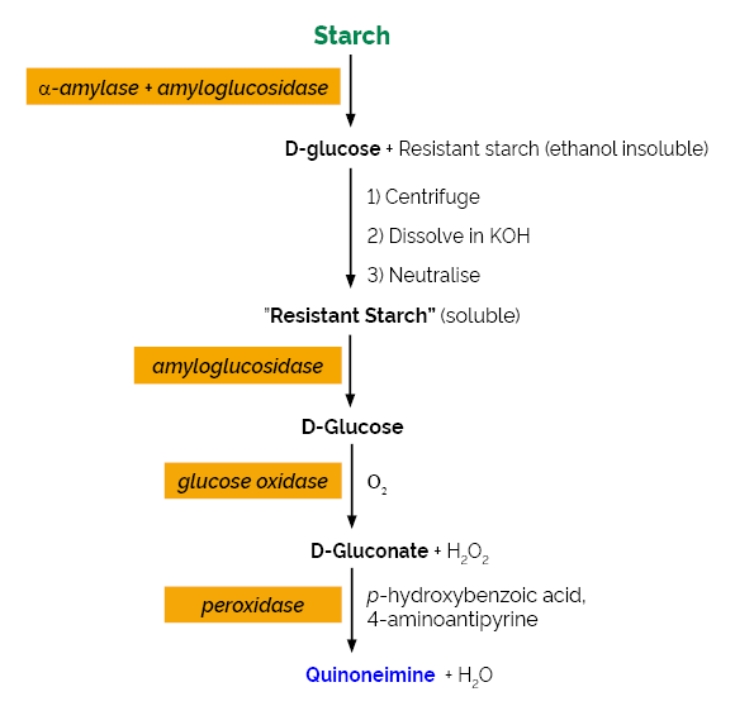- 背景資料
現行衛福部對膳食纖維的定義為:⌈人體小腸無法消化與吸收之三個以上單醣聚合之可食碳水化合物及木質素⌋
故膳食纖維涵蓋範圍廣泛,依據其不同的化學性質或分類方式,可大致分成以下幾類:
1️⃣抗性澱粉(Resistant Starch,簡稱RS),可分成5類,分別為RS1、RS2、RS3、RS4、RS5
2️⃣高分子量膳食纖維 (High Molecular Weight Dietary Fiber,簡稱HMWDF),此類別又可分成
➡️➡️非水溶性膳食纖維( Insoluble Dietary Fiber,簡稱 IDF)
➡️➡️高分子量水溶性膳食纖維(水溶但78%酒精不可溶)(Soluble Dietary Fiber which precipitates in 78% ethanol,High Molecular Weight Soluble Dietary Fiber,簡稱SDFP或HMWSDF)
3️⃣低分子量水溶性膳食纖維(水溶且78%酒精也可溶)( Soluble Dietary Fiber that remains soluble in 78% ethanol,non-digestible oligosaccharides,Low Molecular Weight Soluble Dietary Fiber,簡稱SDFS或NDO或LMWSDF)
.jpg)
- 樣品準備(SAMPLE PREPARATION)
Grind approx. 50 g of sample of grain or lyophilised plant or food product in grinding mill to pass a 1.0 mm sieve. Transfer all material to a wide-mouthed plastic jar and mix well by shaking and inversion. Industrial starch preparations are usually supplied as a fine powder, so grinding is not required. Mince fresh samples (e.g. canned beans, bananas, potatoes) in a hand operated or electric meat mincer to pass an ~ 4.5 mm screen. Determine moisture content of dry samples by AOAC Method 925.10 (15) and of fresh samples by lyophilisation followed by oven drying according to AOAC Method 925.10.
- 操作流程(ASSAY PROCEDURE)
(a) Hydrolysis and solubilisation of non-resistant starch.
i. Accurately weigh a 100 + 5 mg sample directly into each screw cap tube (Corning® culture tube; 16 x 125 mm) and gently tap the tube to ensure that the sample falls to the bottom.
NOTE: For wet samples such as minced canned beans or food products, the sample size is approx. 0.5 g (weighed accurately). With such materials, the moisture content is usually 60-80%.
ii. Add 4.0 mL of solution 2 (pancreatic α-amylase (10 mg/mL) containing 3 U/mL AMG) to each tube.
iii. Tightly cap the tubes, mix them on a vortex mixer and attach them horizontally in a shaking water bath, aligned in the direction of motion (see Figures 2 and 3, page 10).
iv. Incubate tubes at 37°C with continuous shaking (200 strokes/min) for exactly 16 h (Note: for linear motion, a setting of 100 on the water bath is equivalent to 200 strokes/min; 100 forward and 100 reverse).
v. Remove the tubes from the water bath and remove excess surface water with a paper towel. Remove the tube caps and treat the contents with 4.0 mL of ethanol (99% v/v) or IMS (99% v/v) with vigorous stirring on a vortex mixer.
vi. Centrifuge the tubes at 1,500 g (approx. 3,000 rpm) for 10 min (non-capped).
vii. Carefully decant the supernatants and re-suspend the pellets in 2 mL of 50% v/v ethanol (or 50% v/v IMS) with vigorous stirring on a vortex mixer. Add a further 6 mL of 50% v/v ethanol, mix the tubes and centrifuge again at 1,500 g for 10 min.
viii. Decant the supernatants and repeat this suspension and centrifugation step once more.
ix. Carefully decant the supernatants and invert the tubes on absorbent paper to drain excess liquid.
- (b) Measurement of Resistant Starch.
i. Add a magnetic stirrer bar (5 x 15 mm) and 2 mL of 2 M KOH to each tube and resuspend the pellets (and dissolve the RS) by stirring for approx. 20 min in an ice/water bath over a magnetic stirrer (Figure 1, page 8).
NOTE:
1. Do not mix on a vortex mixer as this may cause the starch to emulsify.
2. Ensure that the tube contents are vigorously stirred as the KOH solution is added. This will avoid the formation of a lump of starch material that will then be difficult to dissolve.
ii. Add 8 mL of 1.2 M sodium acetate buffer (pH 3.8) to each tube with stirring on the magnetic stirrer. Immediately 0.1 mL of bottle 1 (AMG, 3,300 U/mL) mix well and place the tubes in a water bath at 50°C.
iii. Incubate the tubes for 30 min with intermittent mixing on a vortex mixer.
iv. For samples containing > 10% RS; quantitatively transfer the contents of the tube to a 100 mL volumetric flask (using a water wash bottle). Use an external magnet to retain the stirrer bar in the tube while washing the solution from the tube with the water wash bottle. Adjust to 100 mL with distilled water and mix well. Centrifuge an aliquot of the solution at 1,500 g for 10 min.
v. For samples containing < 10% RS; directly centrifuge the tubes at 1,500 g for 10 min (no dilution). For such samples, the final volume in the tube is approx. 10.3 mL (however, this volume will vary particularly if wet samples are analysed, and appropriate allowance for volume should be made in the calculations).
vi. Transfer 0.1 mL aliquots (in duplicate) of either the diluted (step iv) or the undiluted (step v) supernatants into glass test tubes (16 x 100 mm), add 3.0 mL of GOPOD reagent and incubate at 50°C for 20 min.
vii. Measure the absorbance of each solution at 510 nm against the reagent blank.
➡️Prepare reagent blank solutions by mixing 0.1 mL of 100 mM sodium acetate buffer (pH 4.5) and 3.0 mL of GOPOD reagent.
➡️Prepare D-glucose standards (in quadruplicate) by mixing 0.1 mL of bottle 5 (D-glucose, 1 mg/mL) and 3.0 mL of GOPOD reagent.
- (c) Measurement of Non-Resistant (Solubilised) Starch.
i. Combine the supernatant solutions obtained on centrifugation of the initial incubation [(a)vii, page 6] with the supernatants obtained from the subsequent two 50% ethanol washings [(a)viii and (a)ix, pages 6 & 7] and adjust the volume to 100 mL with 100 mM sodium acetate buffer (pH 4.5) in a volumetric flask. Mix well.
ii. Incubate 0.1 mL aliquots of this solution (in duplicate) with 10 μL of solution 1 (dilute AMG, 300 U/mL).in 100 mM sodium maleate buffer (pH 6.0) for 20 min at 50°C. Add 3.0 mL of GOPOD reagent and incubate the tubes for a further 20 min at 50°C.
iii. Measure the absorbance at 510 nm against a reagent blank.
iv. Calculate the content of non-resistant (solubilised) starch.
Total starch content is the sum of resistant starch and non-resistant (solubilised) starch.
商品特色
商品規格
- 商品規格(100個檢測反應)
Bottle 1:
Thermostable α-amylase
(10 mL, 3,000 U/mL on Ceralpha reagent* at pH 6.5 and 40°C or 2,500 U/mL on Ceralpha reagent* at pH 5.0 and 40°C).
Store at 4°C or alternatively below -10°C. See individual label for expiry date.
Bottle 2:
Amyloglucosidase
(10 mL, 3,300 U/mL on soluble starch or 200 U/mL on p-nitrophenyl β-maltoside*) at pH 4.5 and 40°C.
Store at 4°C or alternatively below -10°C. See individual label for expiry date. *
Full assay procedure is available at “www.megazyme.com”.
Bottle 3:
GOPOD Reagent Buffer.
Buffer (50 mL, pH 7.4), p-hydroxybenzoic acid and sodium azide (0.09% w/v).
Store at 4°C. See individual label for expiry date.
Bottle 4:
GOPOD Reagent Enzymes.
Glucose oxidase plus peroxidase and 4-aminoantipyrine. Freeze-dried powder.
Store at or below -10°C. See individual label for expiry date.
Bottle 5:
D-Glucose standard solution (5 mL, 1.0 mg/mL) in 0.2% (w/v) benzoic acid.
Store sealed at room temperature. See individual label for expiry date.
Bottle 6:
Standardised regular maize starch control.
Starch content shown on vial label.
Store sealed at room temperature. See individual label for expiry date.


